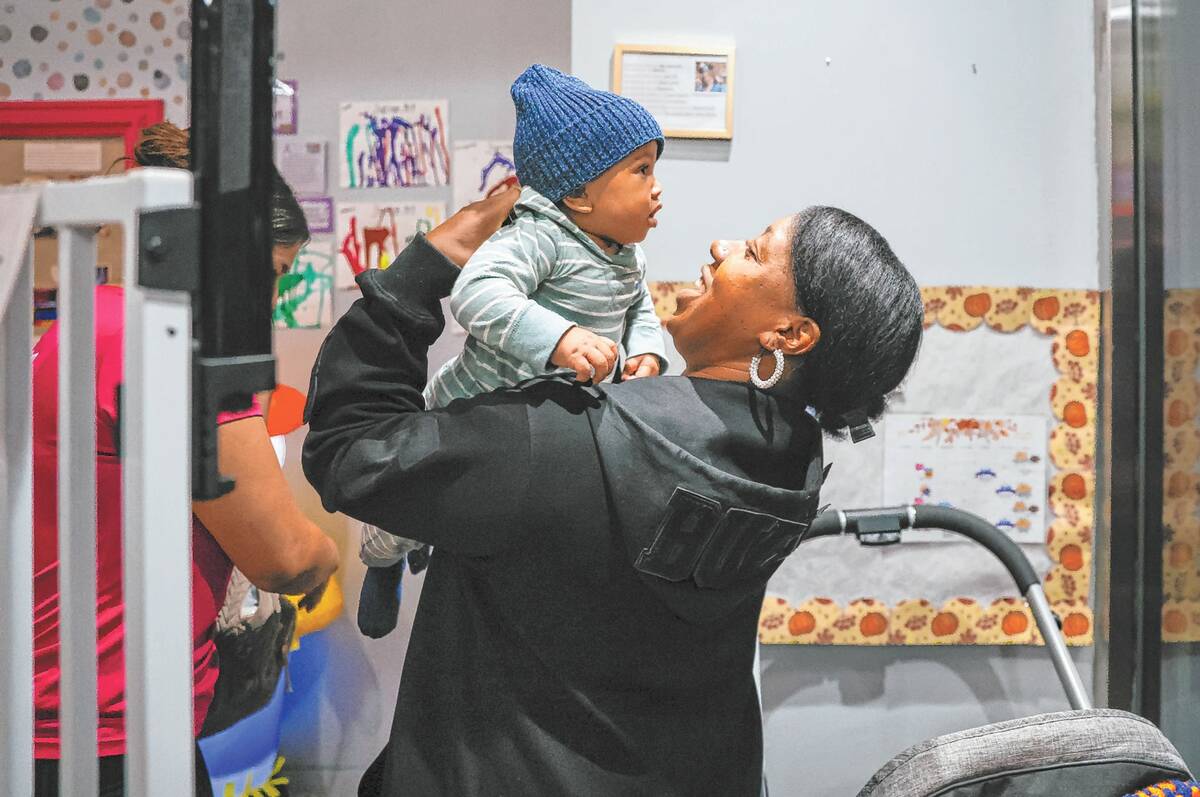‘Make a way out of no way’: Nevada families struggle to make child care affordable
When Jassmyne Collette-Koonce needs to focus on her precalculus classwork, sometimes it’s not as simple as finding a quiet spot in her home.
“If the baby needs me, I’m going to stop studying,” said the Henderson mother of four ranging in age from 7 months to 16 years old.
Collette-Koonce can take her infant to Artsy Nannies, a child care center with flexible hours in Town Square, before heading to the closest library to focus.
But the stop at the center is no regular occurrence. With full-time day care centers at about $400 a week for infant care, she said, Collette-Koonce regularly leans on family and trusted friends to watch her baby when she studies, works or volunteers.
“It’s either I have coverage for the time I have it, or whatever I have planned won’t get done,” she said. “It’s that simple.”
Child care costs weigh heavily on Nevada families. The average annual price of licensed care in Clark County is $12,744 for infants and $10,739 for 4-year-olds. As families worry about rising costs in other parts of their household budget, parents of young children have to contend with additional care costs that amount to more than a year of in-state undergraduate tuition at UNLV.
“Now it’s like the day care costs as much as the rent,” she said. “Which one is more important? Do you have a place for your child to stay, or do you make sure you can send your child to daycare for maybe three, four hours? It’s very stressful.”
‘Make a way’
Collette-Koonce and her children moved to Clark County from New Jersey about five years ago. She said she was looking for a change and wanted to have new experiences with her children. Her younger sister already lived in the area.
“I just was ready to show myself that I could do it. I didn’t have to lean on anybody,” Collette-Koonce said. “But doing that, I was able to come to a realization that I do need help. I’m a single person, and the economy is crazy. It took some time to be comfortable to ask for help.”
Child care costs have an outsized role in the rising cost of living. Labor and other market forces have driven up day care costs in recent years, making it harder for families with young children to earn enough to be self-sufficient. A family with one infant and one preschooler needed to make $8,554 per month ($102,648 annually) in 2024 to cover their costs without public or private assistance — a 40.7 percent increase from 2021, according to the latest available data in a cost-of-living report by nonprofit The Children’s Cabinet.
Collette-Koonce said she went back to school because she wanted more for her family. She was working as a phlebotomist and taking occasional clients as a cosmetologist — her previous career in New Jersey — when she joined the Jeremiah Program, a national nonprofit supporting single mothers through education and family services. Aid and guidance through the program let her focus on attending the College of Southern Nevada for a medical laboratory sciences degree.
That means Collette-Koonce has to find child care for her infant while she is in class or studying throughout the week.
“I try to get whatever resources that I could possibly find because I don’t have an extra $1,200, $1,300 just sitting around,” Collette-Koonce said, adding that infant care is especially expensive because of the additional attention they require.
“You literally have to make a way out of no way,” she said.
Burden of cost
Child care subsidies can help some families make early education more affordable. But eligibility for the state-ran subsidy changed in October 2024 from 85 percent of the state median income to 41 percent, after federal funding from the American Rescue Plan Act ended and brought the threshold back down. A family of three would need to make $2,890 per month ($34,680 annually) or less to qualify for the subsidy.
Families that make just over that are often left in a pinch, said Marty Elquist, chief programs officer at The Children’s Cabinet.
“They’ve got $5,000 that they would have to make up in public assistance before they can be self-sufficient,” Elquist said. “It’s just a no-win situation for families who don’t qualify.”
Las Vegas’ high costs stand out among comparable cities, researchers say. About 20 percent of a family’s wages are directed toward child care in Southern Nevada — the highest in the U.S., according to a November 2024 report by UNLV’s The Lincy Institute and consultant firm Tripp Umbach.
Some of that has to do with labor. Southern Nevada has about 2,025 fewer child care jobs in the local economy than expected based on the population, according to the analysis. Low pay and high turnover among care workers can escalate costs for employers.
“To keep those costs affordable, that is being subsidized on the backs of the child care workforce,” Elquist said, adding that wages are typically around $15 to $17 per hour. “As soon as you start raising wages, you’ve got to raise the price to parents because it’s a private system. But it’s a broken system because it’s built on the backs of women, largely minority women and women of color.”
‘Simple supply and demand issue’
The mismatch in the child care economy has led to a renewed interest in finding solutions, particularly after a state report in 2023 found 74 percent of children under 6 years old in the state did not have access to licensed child care. It also determined that every county in Nevada is a child care desert.
Gov. Joe Lombardo proposed child care center development subsidies this year, but the bill died in the Nevada Legislature. A combined education bill between the Republican governor and state Senate Majority Leader Nicole Cannizzaro, D-Las Vegas, included expanded pre-kindergarten programs.
Jordan Sommaggio, president and CEO of the YMCA of Southern Nevada, said the nonprofit organization is trying to expand a “pop-up” child care model in which it establishes a modular preschool center at a community center or business in a ZIP code that UNLV has identified as having one of the highest child care needs in Clark County. The first was the SkyView Early Learning Village, which opened in 2024.
The Y operates four centers with a capacity of about 275, Sommaggio said. The organization expects to open another modular preschool next year that will add 80 seats.
But that capacity isn’t enough for the need. Enrollment opens at midnight April 1 each year. By the time staff log in that morning, The Y will often have a 200-kid wait list, Sommaggio said.
“This is a simple supply and demand issue,” Sommaggio said. “There are simply not enough providers to serve the number of children in the state that need care. When you have really, really, really high demand and really, really, really low supply — this is economics 101 — then the cost shoots up.”
Contact McKenna Ross at mross@reviewjournal.com. Follow @mckenna_ross_ on X.


















